





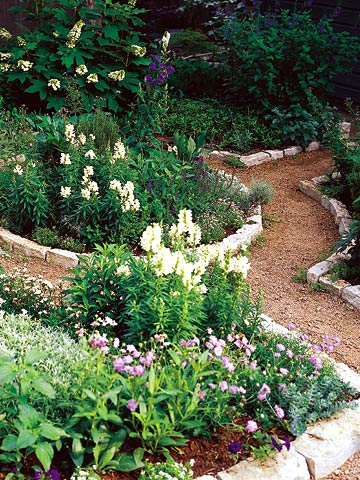 Oakleaf hydrangea, snapdragon,
and sweet alyssum are the stars in this
circular garden, but nuances of
lavender scabious, bellflower,
delphinium, and salvia soften
white's glare.
Oakleaf hydrangea, snapdragon,
and sweet alyssum are the stars in this
circular garden, but nuances of
lavender scabious, bellflower,
delphinium, and salvia soften
white's glare.
Combined with any color, white has the impact of a mint sprig in lemonade: It adds an edge of refreshing crispness. White's chameleonlike nature also makes it the color companion valued most in the garden. Next to warm yellows and reds, white softens. With cool blues and purples, it appears frosty and defined. Free from color, white assumes whatever tint stands next to it.
Drifts of white in a red-hot border lower the temperature. A red-and-white scheme strikes a balance between excitement and relaxation. For a fresh-faced look, pair yellow or orange flowers with white blooms that have warm-color centers.
Best white flowers for your garden.
Planted next to receding blue flowers or foliage, white illuminates, yet the overall effect is quiet and harmonious. Whites drawn from either variegated foliage or flowers become highlights when interspersed among green, particularly in a shady setting. Combined with pink, lavender, or silver, white appears enchanting. White roses peeking out among lavender phlox, or lavender clematis draped on a white arbor, look stunning at twilight.
Best blue flowers for your garden.
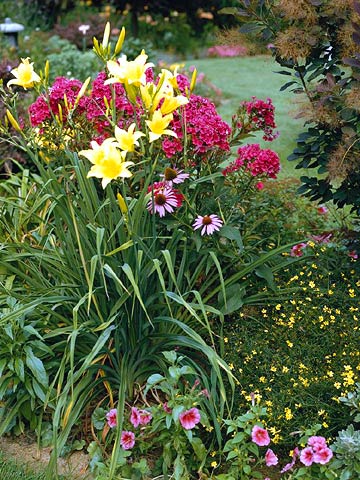 Yellow daylily and coreopsis add
sparkle to a purple palette of
smoke bush, coneflower, petunia,
and phlox.
Yellow daylily and coreopsis add
sparkle to a purple palette of
smoke bush, coneflower, petunia,
and phlox.
When yellow joins other flower colors, the scene invariably lightens and brightens. Yellow boosts the border with the visual equivalent of laughter. It shimmers in shady places.
Purple tones, from purplish green to lavender, respond warmly to a yellow partner. Bright spring yellows frequently pair up with purple and blue blooms. But what about a late-spring follow-up act of yellow peonies (Paeonia lutea) with purple-leaf rhododendrons; lavender irises and gold Veronica repens; or 'Baggesen's Gold' honeysuckle and hardy ginger (Roscoea purpurea)?
Use yellow shrubs as ornamental highlights in flower borders. They'll add spark to mellow monochromes of purple or pink. Many gardeners greet the spring with bright yellow forsythia, but other shrubs also spread wonderful buttery color in plantings. For shade, Kerria japonica bears single or double popcorn flowers of pure gold against vivid green stems. Kirengeshoma, a large perennial, and Rhododendron luteum twinkle with pale yellow flowers, while mahonia glistens with sprays of bright yellow. In sunny gardens, witch hazel and broom (Cytisus) flower in early spring. Golden-leaf varieties of weigela, elderberry, Caryopteris, and barberry enhance borders with their glow.
Best yellow flowers for your garden.
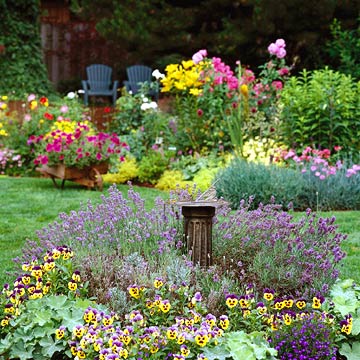 A mass of purple and yellow pansies
shine under a cloud of lavender.
A mass of purple and yellow pansies
shine under a cloud of lavender.
Yellow and white form a winning combination that glows dramatically when reflected in water. A midsummer border could pair fragrant yellow-throated Lilium regale and 'Stella de Oro' daylily, or white astilbe and a gold-variegated ornamental grass. By adding 'Goldenmosa' goldenrod or 'Garden Sun' Helenium and white mums, the gold-and-white show lasts through the fall.
Many daisylike yellow flowers provide late-summer color. Sustain the sunshine of coreopsis, Helenium, and black-eyed Susan by snipping off faded flowers after their first bloom. A second flowering soon follows.
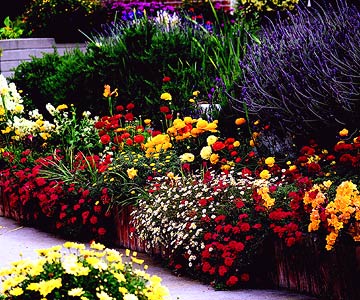 Red Ranunculus and
geranium hold their own
against a sea of yellow
Calendula and other flowers.
Red Ranunculus and
geranium hold their own
against a sea of yellow
Calendula and other flowers.
Reds highlight otherwise subdued colors so they'll be noticed. Warm colors intensify when stationed next to red. Cool classics, such as green and white, look fresh and sparkling when a dash of red is applied among them.
Green, especially, gains vibrancy in the company of its complement, red. The green-and-red leaves of caladium or Euphorbia x martinii look spectacular combined with deep red flowers, including tuberous begonia, fuchsia, and Lobelia cardinalis. Unusual green flowers, such as hellebore or bells of Ireland, go well with reddish-foliage plants. Rich reds, found in roses and peonies, create beautiful relationships with the chartreuse leaves and flowers of lady's mantle or cushion spurge. Any green or chartreuse shrub glows in the company of a red Japanese maple.
Best red flowers for your garden.
Red and yellow make a happy blend of two warm temperaments. Such strong colors should register equal intensity to combine successfully, like pairing golden yellow with bright red. When yellow flowers sport contrasting red centers or markings, such as daylilies, tulips, Coreopsis tinctoria, Gaillardia, and Helenium, the bond grows even stronger.
Red adds a pulse to all-white plantings. White and red roses provide a classic look among dark green foliage. A ribbon of white mums winding around a fall-reddened tree or shrub looks exquisite. Likewise, Japanese blood grass mixed with 'Snowbank' Boltonia or white asters create a stellar combination.
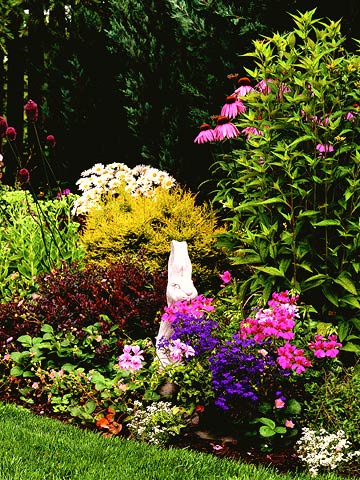 Purples and pinks living in
peace. Contributing plants
include geranium, sweet alyssum,
'The Fairy' rose, lobelia, daisy,
and foliage faves like sedum and
strawberry.
Purples and pinks living in
peace. Contributing plants
include geranium, sweet alyssum,
'The Fairy' rose, lobelia, daisy,
and foliage faves like sedum and
strawberry.
Side by side on the color wheel, reds and oranges also bond in the border. To ensure compatibility, select reds that run to warm crimson rather than cool burgundy. Red flax or poppies mingled with orange butterfly weed creates jewellike effects in a meadow garden setting. A mix of red and peach dahlias sizzles in a hot-weather color scheme, especially if the 'Bishop of Llandaff' dahlia, with its chocolate-color foliage, fills the red role. 'Lady in Red' annual salvia, paired with nasturtiums and 'Peaches and Cream' verbena, strikes equally warm notes up front in the border or arranged in a pot.
Pink and white plantings also radiate warmth, but with pastel overtones. Both colors get along with any other. Paired with each other, however, the combo is as delicious as strawberries and cream. Soft, satiny pink 'Bonica' roses spilling over a white picket fence couldn't ask for any better company than pink-and-white Alstroemeria, magenta penstemon, and the starry white counterpoint of Leucanthemum x superbum.
For a slightly warmer look, introduce yellow to your favorite deep-pink flowers. Gold foliage provides the least intrusive way to play up the color chemistry. Use Helichrysum 'Limelight' to set off magenta petunias, for instance. Rosy phlox and pink coneflowers create striking pairs with golden-flower perennials.
Best pink flowers for your garden.
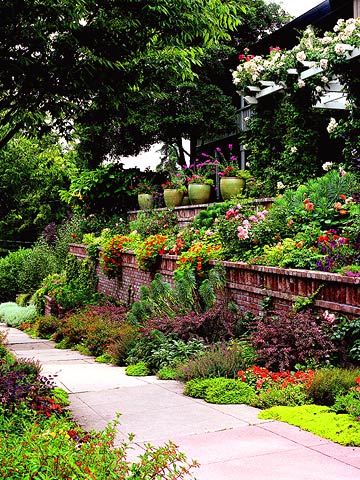 Cascades of nasturtiums, million
bells, dahlias, impatiens, and
Cuphea provide hot-color
counterpoint to the softer
shades of roses and greenery.
Cascades of nasturtiums, million
bells, dahlias, impatiens, and
Cuphea provide hot-color
counterpoint to the softer
shades of roses and greenery.
Closely related on the color wheel, pink and purple make a successful team in the garden. Annual Salvia viridis furnishes both colors on spiky stalks. Purple larkspur pairs beautifully with pink poppies, and lisianthus goes with pink 'Garden Bride' baby's breath. Violet clematis and pink roses paint a rich, two-tone portrait. Purple basil makes a stunning foliage filler in a bed of pink blooms. An early-spring scene features pink creeping phlox and purplish-blue forget-me-not. Pink autumn crocus and purple-bronze Ajuga combine for fall.
Make purple pop by adding an orange partner, such as tall zinnias accompanying 'Purple Rain' salvia, or match blooms of lavender bellflower with coral 'Elfin Pink' penstemon.
Best lavender flowers for your garden.
Best purple flowers for your garden.
Best orange flowers for your garden.
Copyright © www.100flowers.win Botanic Garden All Rights Reserved